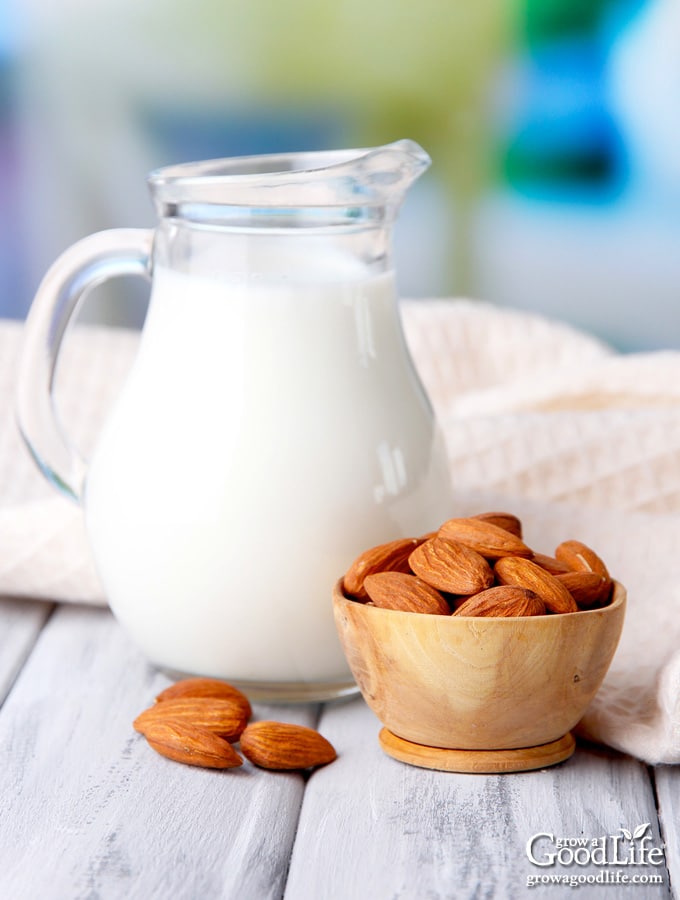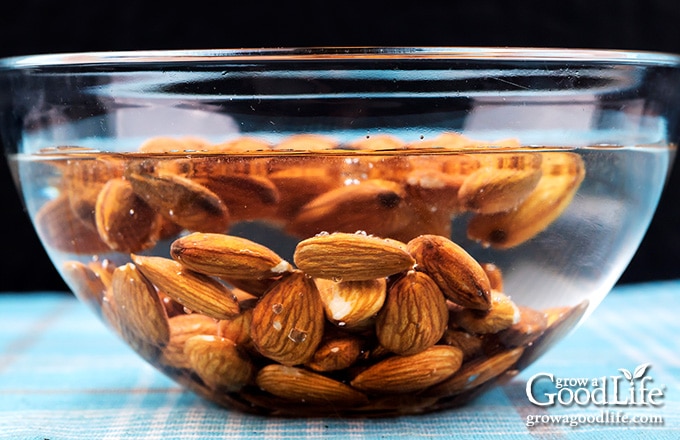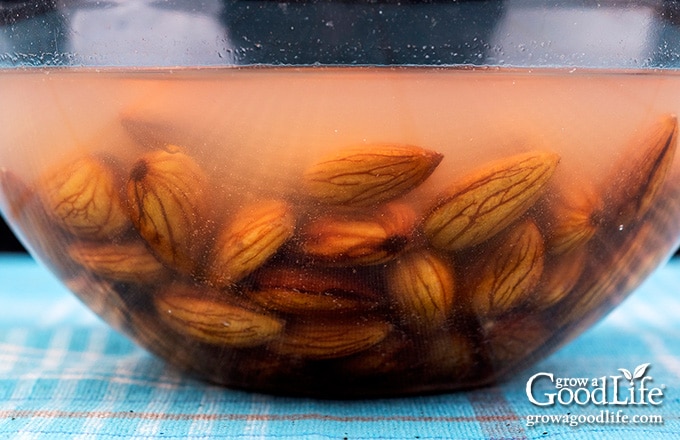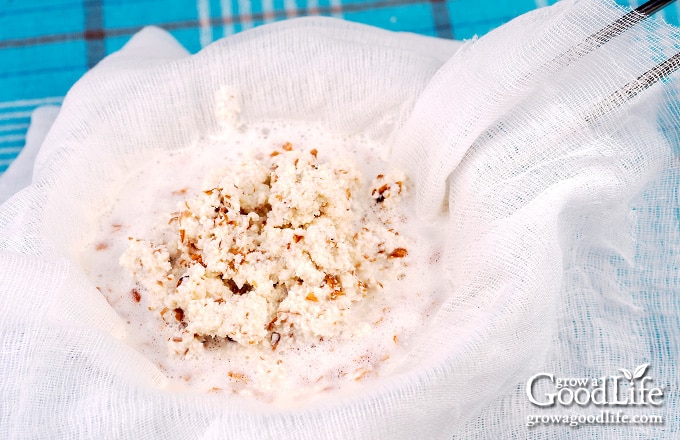How to Make Almond Milk
This post may contain affiliate links, which means that I may receive a commission if you make a purchase using these links. As an Amazon Associate I earn from qualifying purchases.
Almond milk is a plant-based beverage made from almonds and water. It is a dairy-free milk substitute for vegan diets or for those who are lactose intolerant or allergic to cow’s milk. Learn how to make your own and avoid the additives found in store bought almond milk.

A few years ago, we discovered that my husband has developed allergies to cow’s milk. It was a difficult realization since he loves milk in his morning cereal, ice cream desserts, cream in his coffee, and enjoys cheese. All of these things had to be reduced, eliminated, or replaced with other alternatives.
Thankfully, almond milk filled much of that void. Almond milk can be purchased in the dairy section in your local grocery store. It is a good dairy-free replacement for regular milk and can be used in smoothies, on breakfast cereal, and in baked goods.
Unfortunately, we discovered that most commercial almond milk contains additives and thickeners, including sugar, sodium, gums, artificial flavors, lecithin, and carrageenan. I wondered if I could make almond milk at home.
A quick web search answered my question. I was happy to find that making almond milk from scratch was much easier than I thought. The homemade almond milk has a fresh, cleaner flavor than the store bought without the waxy aftertaste. I tried several recipes and after a few tweaks with the proportions and flavors…we had a winner.
Tips for Making Almond Milk
You can make your own almond milk with just a few ingredients and common kitchen tools. This recipe makes unsweetened almond milk that has a mild nutty almond flavor and a light creamy texture.
Plain almond milk works well as a neutral 1:1 milk replacement in savory recipes such as mashed potatoes, creamy soups, chowders, and cream based gravies. You can also replace the milk in baked goods with great results. See the notes below for ways to add flavor and make a richer almond milk coffee creamer.
Use Raw Almonds
Raw, unsalted, and lightly steam pasteurized whole almonds work best for making almond milk. Use fresh almonds that taste nutty and have no bitterness. If you buy almonds in bulk, you can keep them fresh by freezing them. Place in an airtight container or freezer bag and freeze for up to two years.
Don’t Skip the Soaking Step
Soaking the nuts is essential for achieving a creamy almond beverage. Soaking softens the almonds, making them easier to break down when blended.
Use a Blender or Food Processor
You will need a high-speed blender or food processor to grind the almonds and blend them with water. A blender will grind the almonds very fine and make a smooth textured almond beverage. Expect a little more grit from the food processor.
Make Small Batches
Since there are no preservatives, almond milk will only last about three days in the fridge. Only make what you will use up in a few days.
How to Freeze Almond Milk
Almond milk does freeze well. So you can make larger batches and freeze in individual freezer containers. Remove each container as needed and place in the refrigerator to thaw overnight to thaw.
Ways to Use the Almond Pulp
Don’t toss the leftover pulp. It can be used in so many ways, including topping oatmeal, cereal, and yogurt. You can also dry almond pulp in a low oven or dehydrator and blend it into almond meal that can be used as a gluten free breadcrumb replacement for an extra crunchy nutty flavor to fried green tomatoes, chicken fingers, and baked onion rings.
Steps to Make Unsweetened Almond Milk
Yes, it is easy to make almond milk from scratch! You can avoid the additives by making your own homemade almond milk with just almonds and water. Learn how to make plain almond milk, and then sweeten and flavor to your taste.
Here are the illustrated steps to make unsweetened almond milk. Scroll down to the end of this article for the full recipe, plus ways to add extra flavor.
Step 1: Soak the Almonds
Sort through the almonds and discard any that are discolored or shriveled. Measure and place the almonds in a bowl, cover with about one inch of water, pop it into the refrigerator, and soak the nuts overnight or up to two days.

As the nuts soak, they absorb water, swell, and become soft making it easier to process into a creamy liquid. The flavor of the almonds mellows and becomes less bitter. The longer the almonds soak, the creamier the almond milk will be.

Step 2: Blend with Water
Drain the almonds and discard the soaking water. Rinse the nuts and add to a blender or food processor. Add fresh water, and salt if using.

Blend on high until creamy and smooth, about 1 to 2 minutes. Depending on the size of your food processor bowl, you might need to stop and scrape the edges of the bowl, and process longer to blend the almonds well with the water.

Step 3: Strain the Mixture
Place a fine mesh strainer over a clean bowl. Layer it with a jelly bag, nut bag, or triple layer of cheesecloth. Pour the almond milk into the strainer and let it drain. Go ahead and squeeze out as much liquid as you can. You should be able to squeeze out about four cups of almond milk.

Use the almond milk immediately, or store in clean jars in the refrigerator for up to three days. Some settling may occur. Give the jar a shake right before using.
Ways to Flavor Almond Milk
Plain, neutral flavored almond milk is ideal for replacing milk in baked goods, soups, and salad dressings. If you are drinking it, you may enjoy a little added sweetness and extra flavor. Try the following:
- Sweetened Almond Milk: For sweetening, you can stir in 1 to 2 tablespoons sugar, honey, or maple syrup to the almond milk. Or even try blending a couple dates with the almonds, and then strain out the solids.
- Vanilla Flavored: Add one teaspoon vanilla extract for a vanilla flavored almond milk. Almond milk with a hint of vanilla flavor tastes good poured over cereal and oatmeal.
- Extra Almond: For more almond flavor, add about 1/4 teaspoon of almond extract.
- Chocolate Almond Milk: After straining, return the almond milk to the blender and add 2 tablespoons sugar, 2 tablespoons of unsweetened cocoa powder, and blend until combined.
- Strawberry Almond Milk: Add 1/2 cup of fresh strawberries to your recipe before blending.

How to Make Almond Milk Coffee Creamer
While you can add regular almond milk to your coffee, we found it lacking the thicker texture of cream and half and half. It was an easy adjustment. Simply reduce the amount of water for thicker almond milk that mimics cream. We like a ratio of 1 cup of soaked almonds and 2 cups of water for a creamier almond milk to use as a coffee creamer.

How to Make Almond Milk
Ingredients
- 1 cup raw almonds
- 4 cups water
- pinch sea salt optional for flavor
Instructions
- Sort through the almonds and discard any that are discolored or shriveled. Place one cup of almonds in a bowl, cover with 1-inch of water. Soak the nuts overnight or up to 2 days in the refrigerator.
- After the nuts have soaked, drain and discard the soaking water. Rinse the nuts and add to a blender or food processor. Add water and salt, if using.
- Blend on high until creamy and smooth, about 1 to 2 minutes. Scrape the edges of the bowl, and continue to blend the almonds well with the water.
- Strain the almond milk through a jelly bag, nut bag, or a triple layer of cheesecloth. Squeeze out as much liquid as you can. You should be able to squeeze out about four cups of almond milk.
- Use the almond milk immediately, or store in clean jars in the refrigerator for up to 3 days. Some settling may occur. Give the jar a shake right before using.
Notes
- Sweetened Almond Milk: For sweetening, you can stir in 1 to 2 tablespoons sugar, honey, or maple syrup to the almond milk. Or even try blending a couple dates with the almonds, and then strain out the solids.
- Vanilla Flavored: Add one teaspoon vanilla extract for a vanilla flavored almond milk. Almond milk with a hint of vanilla flavor tastes good poured over cereal and oatmeal.
- Extra Almond: For more almond flavor, add about 1/4 teaspoon of almond extract.
- Chocolate Almond Milk: After straining, return the almond milk to the blender and add 2 tablespoons sugar, 2 tablespoons of unsweetened cocoa powder, and blend until combined.
- Strawberry Almond Milk: Add 1/2 cup of fresh strawberries to your recipe before blending.
Nutrition
You May Also Like:
Good planning is key to a successful vegetable garden
Whether you are new to growing your own food or have been growing a vegetable garden for years, you will benefit from some planning each year. You will find everything you need to organize and plan your vegetable garden in my PDF eBook, Grow a Good Life Guide to Planning Your Vegetable Garden.


I really love almond milk. I’ll drink almond milk first thing in the morning thank you for sharing this recipe. I will try to do this often thanks a lot!